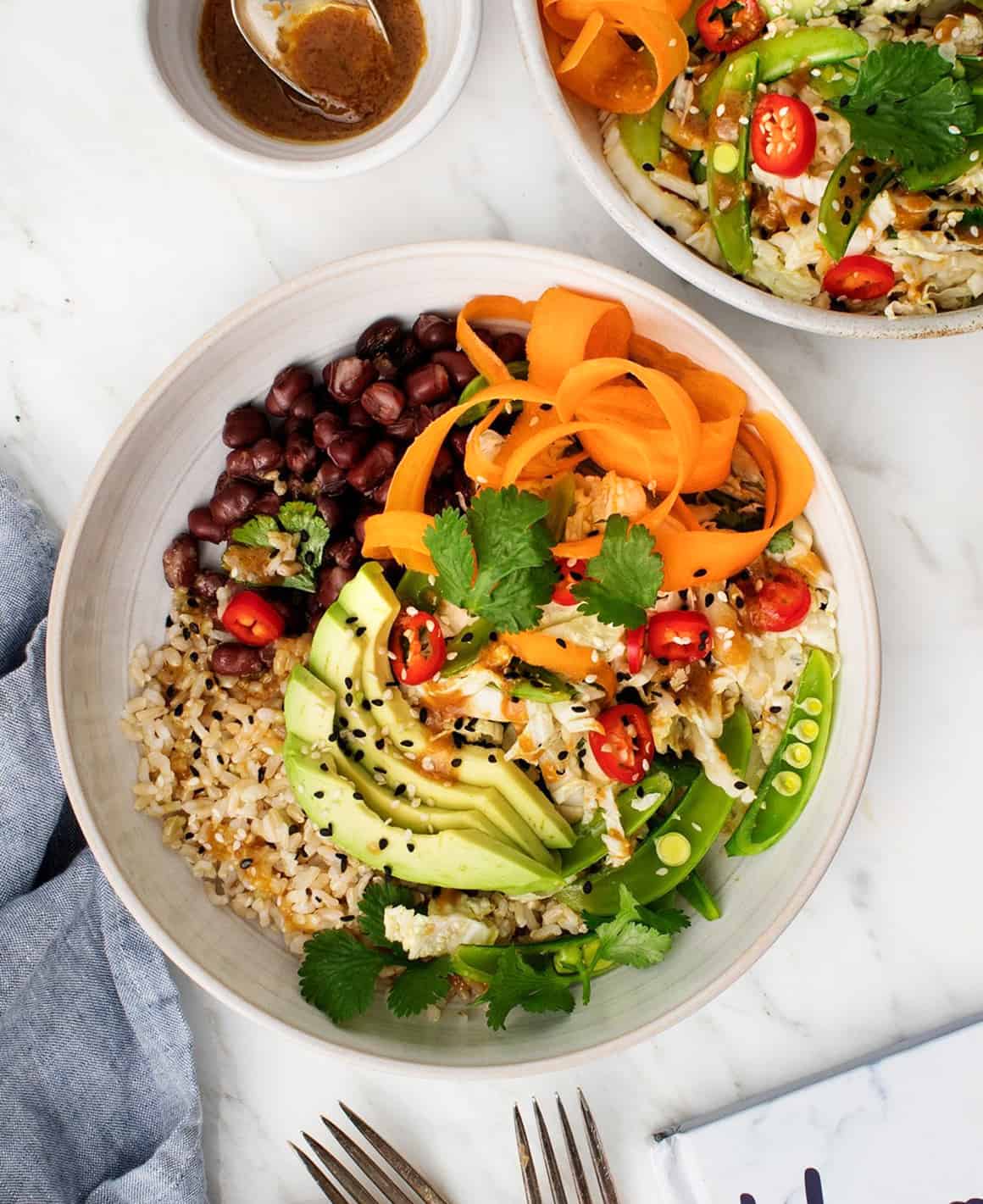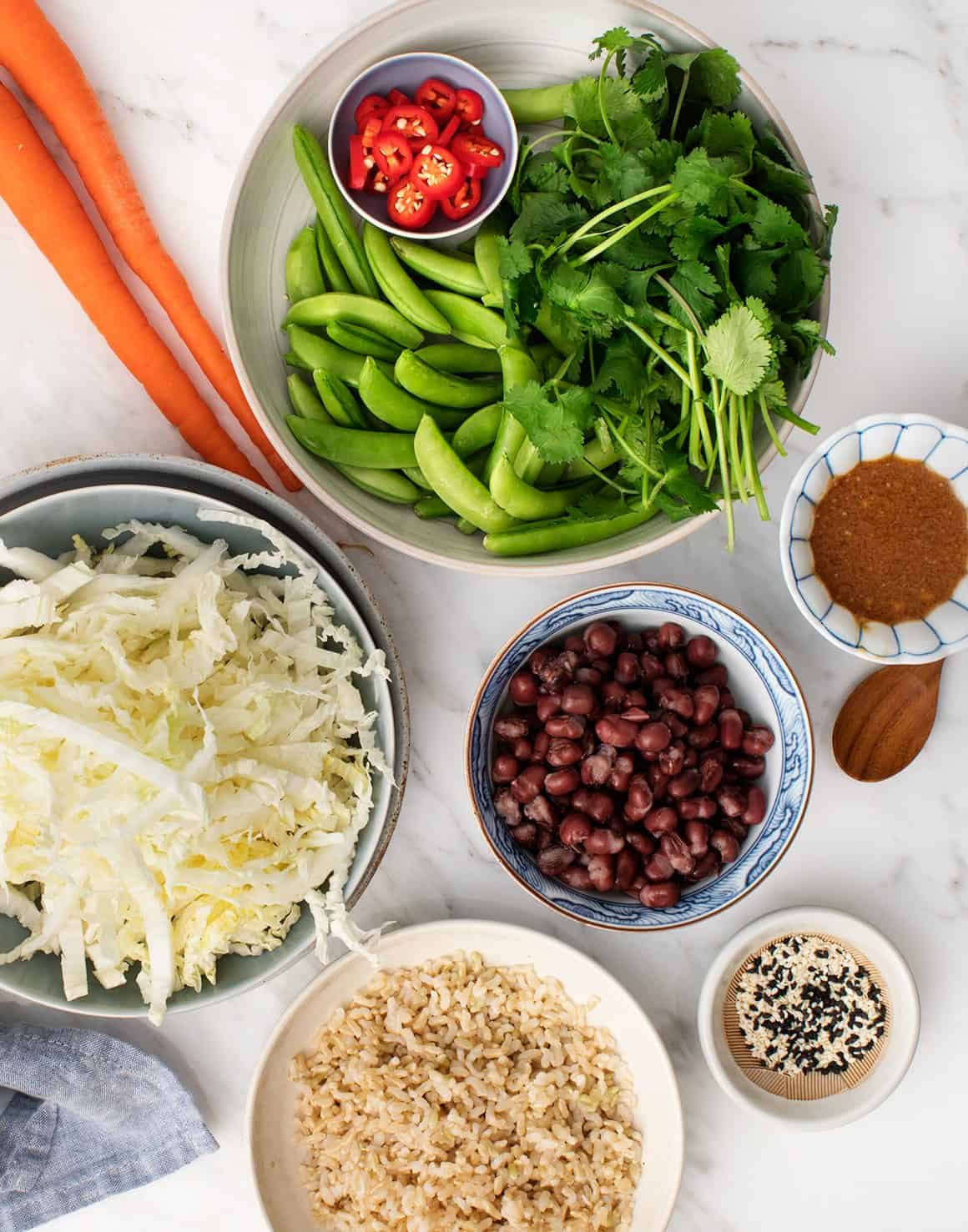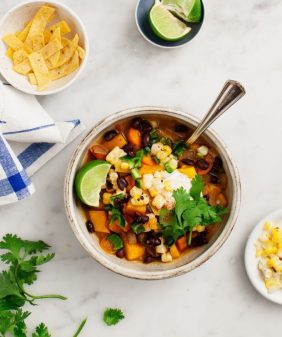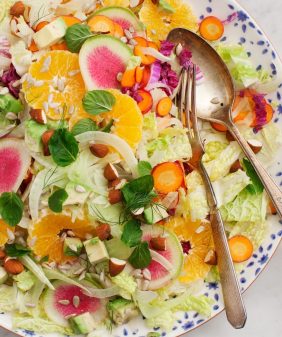Never tried adzuki beans? Learn how to cook them for this tasty grain bowl recipe! And don't worry, if you can't find them, black beans work here too.

Have you ever tried adzuki beans? If you haven’t, you totally should. Like most bean varieties, they have a host of health benefits. They’re packed with protein and fiber, and they’re even said to promote heart health by lowering blood pressure and cholesterol levels. Because of their small size, they cook quickly, and last but not least, they’re delicious! Their unique sweet, nutty flavor is at home in everything from hearty grain bowls to Japanese ice cream.
If you’re ready to try them, find my method for how to cook adzuki beans below, along with my all-time favorite adzuki beans recipe.

How to Cook Adzuki Beans
While it’s possible to find canned adzuki beans, you’ll more often see them dried. Unlike other dried beans, there’s no need to soak adzuki beans before you cook them. Even without soaking, they typically cook in less than 90 minutes on the stove! In fact, because they cook relatively quickly, I prefer the dried beans to canned ones. Cooking adzuki beans yourself allows you to control their final texture, and you can amp up their flavor by simmering them with aromatics like quartered onions, smashed garlic cloves, bay leaves, or black peppercorns.
Want to try it? Here’s my easy method for how to cook adzuki beans:
- First, pick them over. Small stones or debris are often mixed in with dried beans, so sift through the beans before you cook them. Discard this debris along with any shriveled or discolored beans, and rinse the beans in a fine mesh strainer under running water.
- Then, cook them! Place the beans in a large pot, and add cold water to cover them by 2 inches. Season them with salt, and add any aromatics to the pot. Bring to a boil, reduce the heat, and simmer until the beans are tender, but not mushy. This could take anywhere from 35 to 90 minutes, depending on the freshness of your beans (note: if your beans are very old, they could take a little longer). If the beans begin to dry out as they cook, add more water to the pot, as needed.
- Finally, eat or store the beans. When the beans are tender, eat them hot off the stove with a ladle of their cooking liquid, drain them to use in your favorite adzuki beans recipe, or store them for later use. Refrigerate them in an airtight container for up to 5 days, or freeze them for several months.

Adzuki Beans Recipe Components and Variations
This Adzuki Bean Bowl from the cookbook Healthyish is my all-time favorite adzuki beans recipe. The sweet, nutty beans pair perfectly with earthy brown rice and a crisp, miso-dressed slaw. All these components keep well if you prep them ahead of time, so this recipe would be a fantastic make-ahead lunch or weeknight dinner. And if you don’t have these exact ingredients on hand, don’t worry! Like most good grain bowls, you can easily swap in what you do have. Here’s what the recipe calls for, plus a few ideas for easy substitutions:

- Cooked adzuki beans – The main event! If you can’t find them, use black beans instead. I often use them interchangeably. For speedy assembly, cook the adzuki beans up to 3 days in advance, or use canned beans.
- Brown rice – Red beans and rice are a classic pairing, and these tasty bowls show why! If you don’t have brown rice on hand, white rice, cauliflower rice, or quinoa would also work well here.
- Napa cabbage, snap peas, and carrots – Use this combination, or swap in your favorite crispy veggies to make the slaw for this bowl. Snow peas, cucumbers, green onions, or red or green cabbage would all be delicious.
- Cilantro – I love to finish grain bowls with a fresh herb. The cilantro is wonderful here, but mint or Thai basil would work too.

- Sesame Miso Dressing – This has become one of my go-to dressings. It’s made with white miso paste, rice vinegar, sesame oil, tamari, and olive oil.
Finish the bowls with creamy avocado, red chiles, and toasted sesame seeds or crushed cashews. Let me know what variations you try!

More Favorite Grain Bowls
If you love this adzuki beans recipe, check out the Healthyish Cookbook! It has a mix of really-healthy and mostly-healthy recipes, hence the name. The book is not entirely vegetarian, but there are SO MANY vegetarian recipes. I have my eye on the Linguine with Trumpet Mushroom “Scallops” and the Smoky Cauliflower and Onion Frittata. I hope you love this book as much as I do!
Then, try one of these grain bowls for more healthy recipe inspiration:
- Tamago Kake Gohan
- Bibimbap
- Roasted Veggie Grain Bowl
- Best Buddha Bowl
- Sesame Soba Noodles
- Or any of these 15 healthy rice bowl recipes!
Or find more of my best bean recipes here!

Adzuki Bean Bowls
Ingredients
- 1/2 large Napa cabbage head, sliced (6 1/2 cups)
- 3 small carrots, shaved with a vegetable peeler
- 1 cup sugar snap peas, sliced
- 2 tablespoons sesame seeds, more for serving
- 1 cup cooked brown rice
- 2 tablespoons chopped fresh cilantro leaves, more for serving
- 1 1/2 cups cooked adzuki beans, drained and rinsed
- 2 avocados, sliced
- 1 small fresh red chile, sliced
Sesame Miso Dressing (makes extra)
- 1/4 cup white miso
- 1/3 cup rice vinegar
- 1/4 cup olive oil
- 3 tablespoons tamari
- 1 tablespoon toasted sesame oil
Instructions
- Make the dressing. In a small bowl, whisk together the miso, rice vinegar, olive oil, tamari, and sesame oil.
- In a large bowl, mix the cabbage, carrots, snap peas, and sesame seeds with 1/4 cup of the dressing.
- Just before serving, fold the cilantro in the cabbage salad. Divid the rice, cabbage salad, beans, and avocados among four bowls. Drizzle with more dressing, as desired, and sprinkle with the chile and more cilantro and sesame seeds, if you like.
Notes














Hello Love and Lemons, Thank you for a wonderful recipe! Delicious and so pretty to look at. The dressing is fabulous, it’s become my go-to. The combination of flavors are so yummy! When I cannot find adzuki beans, I substitute with black beans or chick peas. Always a winner!
This Adzuki Bean Bowl recipe looks delicious! I love the flexibility of swapping ingredients and the idea of using sesame miso dressing. Thanks for the easy bean-cooking tips.
Hi, so glad you enjoyed the tips! I hope you love the recipe if you try it!
The entire family loved this recipe-it was ridiculously good. No substitutions or omissions. Thank you so much!
Oops forgot to rate.
Hi Jess, so glad it was a hit!
I can’t eat miso. What is a substitute? Without miso, recipe looks delicious!
Hi Judith, this sesame ginger dressing (without miso) would be delicious on these bowls instead: https://www.loveandlemons.com/sesame-ginger-dressing/
Not a fan of the dressing
I am confused do you server this with hot rice and beans and cold veggies or is it all served cold?
Hi Dana, the rice and beans can be warm or at room temp and the vegetables are cool. If you’re meal prepping, it can all be served cold.
i made this recipe – It was delicious, a super big hit! However, the beans took a really long time to cook (like 2 1/2 hours!!!!) What did I do wrong?
Hi Eylana, it just means that your beans are older. There can be such a huge time difference depending on the freshness of beans (although they’re still good). Thanks for letting me know, I’ll add a bigger range to the notes.
Took forever to cook. I planned on serving this to company but ran out for take-out instead because it took hours more for the bean to cook.
Hi Susan, I’m sorry, I should have clarified that I make the beans in advance.
Try cooking the beans without salt or flavourings. Add these only when soft.
Hello!
Looks amazing! I’m going to make today.
Where is the recipe how to prepare the adzuki beans?
I can’t find a good one that I love…
Thanks!
I liked this recipe but we didn’t like the dressing. It was so salty and kind of bitter.
It’s definitely salty on it’s own, but I thought Lindsay’s dressing covered and seasoned the large amount of cabbage, veggies, and un-seasoned beans nicely.
Can all of this (except the avocado) be prepared the night before?
Hi Jessica – it can – the cabbage part will get a little watery (and will look less pretty), but I ate this on the second day and still thought it was super delicious. If you wanted to prep it for multiple days to come, I would just store the dressing separately from the vegetables.
DELISH! My boyfriend, who claims to not like beans or cabbage, raves about this and said he could eat it every night. Our toddler even took a few bites out of my bowl!
Yay, I’m so glad it was such a big hit! I could eat these every day too
Delicious recipe! Love the red Beans and Soy sauce. Thanks for sharing!
Any recipe that calls for sugar snap peas is usually a win for me. I just love those things. And it’s even got advocado to boot!
Thanks for both replies – I have not made a raw salad before so I wasn’t sure. Will be trying this over the weekend. xx
Hi! This sounds so good and fresh. Do you not cook the cabbage and sugar snap peas? Is it because they ‘pickle’ in the dressing? If so, could you add bok choy in the same way or would you recommend a quick cook on that first?
It’s not cooked, they’re just fresh, crisp and raw and they soak up the dressing nicely. I’ve made raw bok choy salads before – slice the stem part pretty thin and let it sit in the dressing for a few extra minutes. I hope that helps!
if you preferred to lightly steam or saute the bok choy, that would be delicious as well – the recipe is flexible enough, either way would be fine.
YESSS! Such a jam-packed bowl!!
This sounds like an awesome winter bowl. A little fresh and crunchy but still using lots of winter veg! The book looks great, too, I’ve been hearing so much about it.
Well, your food is the kind of approachable, real life, I-can-make-that food as well. So I can see why you’re drawn to Lindsay’s style. I love the idea to cook rice like pasta – takes all the guess work out of it. And that miso dressing combined with the crunchy veggies and adzuki beans sound wonderful!
This can’t really have a tablespoon of salt added to the rice can it? Seems like a lot.
The rice is boiled like pasta in pasta water, so you’re not consuming that much salt – just a different method of cooking rice. Hope that clarifies things!